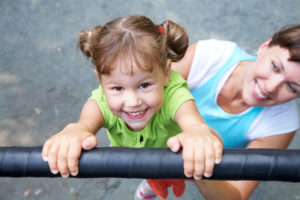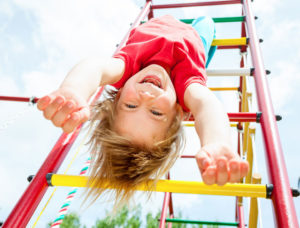Playground Safety Tips
Playing helps your child develop emotionally, intellectually, socially, and physically (see The Importance of Learning Through Play for more details about the benefits of play.) However, the potential for injury could be as serious as the benefits, so here are some playground safety tips to keep your child’s play time fun and injury free.
Supervise

Nearly half of all playground accidents are due to lack of adult supervision. The National Program for Playground Safety (NPPS) recommends that adults should always be present when children are playing at a local park, a school playground, childcare center, or on the equipment in your backyard.
How to Supervise
NPPS recommends following the “ABC’s” of playground supervision:
- Anticipate – Be aware of and try to avoid preventable problems and hazardous situations. This could involve separating smaller children from older (and perhaps rougher) players and checking for hazardous or broken equipment. Another suggestion is to have a first aid kit with bandages and a wound cleanser of some sort on hand.
- Behavior – Watch for inappropriate or dangerous behavior from children and intervene if needed. The adult supervisor’s behavior should also be addressed. Adults who are supervising play need to stay alert and attentive and walk around to make sure that all play areas are supervised. Don’t get caught up in conversations and find yourself distracted. Don’t run inside to answer the phone and leave the children unattended. Take the opportunity to get involved in play with your child and build those wonderful childhood memories!
- Context – Persons who are responsible for supervising a large number of children should be trained. They should know what to look for, when to intervene, and how to take care of injuries.
A Family that Plays Together, Stays Together
Playing with your child builds a bond that will last forever. The Child Development Institute published an article about the benefits of parent/child playtime titled Playing With Your Child. In the article, they state that children crave time with parents. It makes them feel special. Parents are encouraged to find time to spend playing with their kids on a regular basis.
Allowing your child to have “free play”, does not mean it should be unsupervised; it means they should be free to be spontaneous and creative. Our lives revolve around our calendars, so having unstructured playtime is an important part of your child’s development. Get involved in your child’s playtime and you too will enjoy the benefits of healthy, fun playtime and you will probably find yourself enjoying it as much as your child does!
Equipment
Properly designed and functioning playground equipment is an important part of safe playtime. Your equipment should be age-appropriate and not be too large or too small. Likewise, protective surfacing should be installed under and around the playground equipment. Finally, make sure that playground equipment is properly maintained.
Age-Appropriate Playgrounds
Allowing a child to play on equipment that is too small or too large can potentially cause injuries. The NPPS has some excellent recommendations to consider for age-appropriate playground equipment (Click here to read their recommendations). Due to individual differences in a child’s development, you need to use your own discretion in deciding what playground equipment you allow your child to use. And, as always, supervise your child even if you believe that the equipment is age-appropriate.
If you are considering purchasing a playset from Amish Direct Playsets, you can contact our design consultants. They are happy to work with you to determine what equipment is best for your child and can assist you in customizing a playset that will grow with your child.
Proper Fall Surfacing
This is an important topic. Statistics indicate that nearly 70 percent of all playground injuries are related to falls. Thus, it is not recommended to use hard surfaces, such as asphalt, cement, dirt, or grass under and around your playset or playground equipment. Depending on the application, safety experts recommend the use of the following loose-fill or synthetic surface materials:
- Hardwood wooden fiber
- Shredded rubber
- Sand
- Pea gravel
Properly Maintained Playground
Broken or poorly maintained playground equipment can increase the chances of injury. Whether you are at home or in a public playground, look it over before allowing your child to play. The obvious things to look for are objects that could scrape or lacerate the skin or cause entanglement or strangulation. You should also keep an eye out for unhealthy dangers, such as animal droppings, broken glass, garbage, and other similar objects.
When inspecting playground equipment look for:
- Damaged or missing protective covering
- Sharp edges and points
- Exposed pipes
- Animal excrement
- Missing or broken moving parts
- Storm or weather damage
- Missing or loose screws or other connectors
- Any dangling ropes or similar objects
- Trash
- Rusty equipment
It is equally important to only use manufacturer’s replacement parts. Even screws purchased at a hardware store could cause a risk, as they may not be constructed to handle the rigors of playground use. When your child’s safety is at risk, do not hesitate to contact a repair professional.
Education/Preparation
Teach your child how to prepare properly for a playground session. This involves making sure your child is not wearing any clothing that could cause an injury. In addition, teaching your child about proper playground behavior is an important part of making sure your playtime will go smoothly.
Clothing
An important part of preparing your child for safe playtime is to make sure they are appropriately dressed. You want them to be comfortable and able to move around freely, but there are also some serious injury risks that you may not think of. For instance, you may think a sweatshirt or sweatpants are acceptable for your child to wear to the playground, but if there is a drawstring there is potential for it to get caught on the equipment and cause injury — even strangulation. Conversely, you may believe that insisting your child wear a helmet at play is keeping them safe, but it actually increases their risk of strangulation. (See this article by the Consumer Product Safety Commission.)
Here are some guidelines for safe dress:
- Remove any jewelry
- Do not use purses, scarves, hats with ties, mittens with strings, etc.
- Pull out drawstrings from clothing
- Long pants and long-sleeved shirts prevent scrapes, bug bites, etc.
- Make sure shoelaces are tied — even better, only use shoes without laces
- Use closed-toe shoes to prevent rocks, gravel, and other items from becoming stuck in the shoes or causing injury
- Keep long hair pulled back to prevent it from becoming caught
- Do not use a helmet
Rules

Teaching your children (and enforcing) proper playground behavior will help keep them and other children safe. Some types of improper behavior (like pushing and shoving) are obvious, but there are other forms of improper behavior that we probably see all the time and do not necessarily recognize as being risky. So, take the time to educate yourself and your child about safe playground behavior by reading the following tips.
General Guidelines
- Do not push or rough-house — especially while on playground equipment
- Do not jump off high equipment
- If equipment is okay to jump off, make sure no other kids are in the way and land on both feet with knees slightly bent (like a gymnast)
- Keep items like backpacks and bicycles away from the play area so others do not trip on them
- Wet playground equipment could be slippery
- In hot weather, make sure any playground surfaces are not too hot to use
- Always use sunscreen
Swings
- Do not stand or kneel on the swing
- Hang on to the swing with both hands
- Do not jump from the swing in mid-air
- Keep a wide distance from other children who are swinging, whether you are on the ground or in another swing
- Get off from the swing only after it is completely stopped
- Do not ride on a swing with more than one person
Slides
- Never, ever, ever climb up the slide surface; make sure to use the stairs to get to the top of the slide
- When climbing the stairs, take your time and use the handrail
- Always slide down feet first; never, ever, ever slide down head-first or on your stomach
- Do not slide down in groups (like a chain)
- Only one child should be on the slide platform (ready to go) at a time
- Before going down the slide, make sure that the bottom of the slide is clear
- When you reach the bottom of the side, get off the slide and move away as quickly as possible to avoid being run into by another slider
Climbing Equipment
- Use both hands when climbing
- Keep a distance from the climber above you to avoid being kicked or having your fingers stepped on
- Make sure all climbers are on the same side of the equipment
- If you are climbing down, keep an eye out for kids that are climbing up
- Do not climb if there are already a lot of kids on the climbing equipment; wait for it to clear out
- Do not jump from the bars.
- If you are a safe height and want to drop from the bars, hang as low as you can and make sure you are clear of equipment and other children
At Amish Direct Playsets our desire is for you to enjoy many years of safe and memorable play with your child, so rest assured that all of our playset equipment has been designed with your child’s safety in mind. Stay safe and enjoy!
